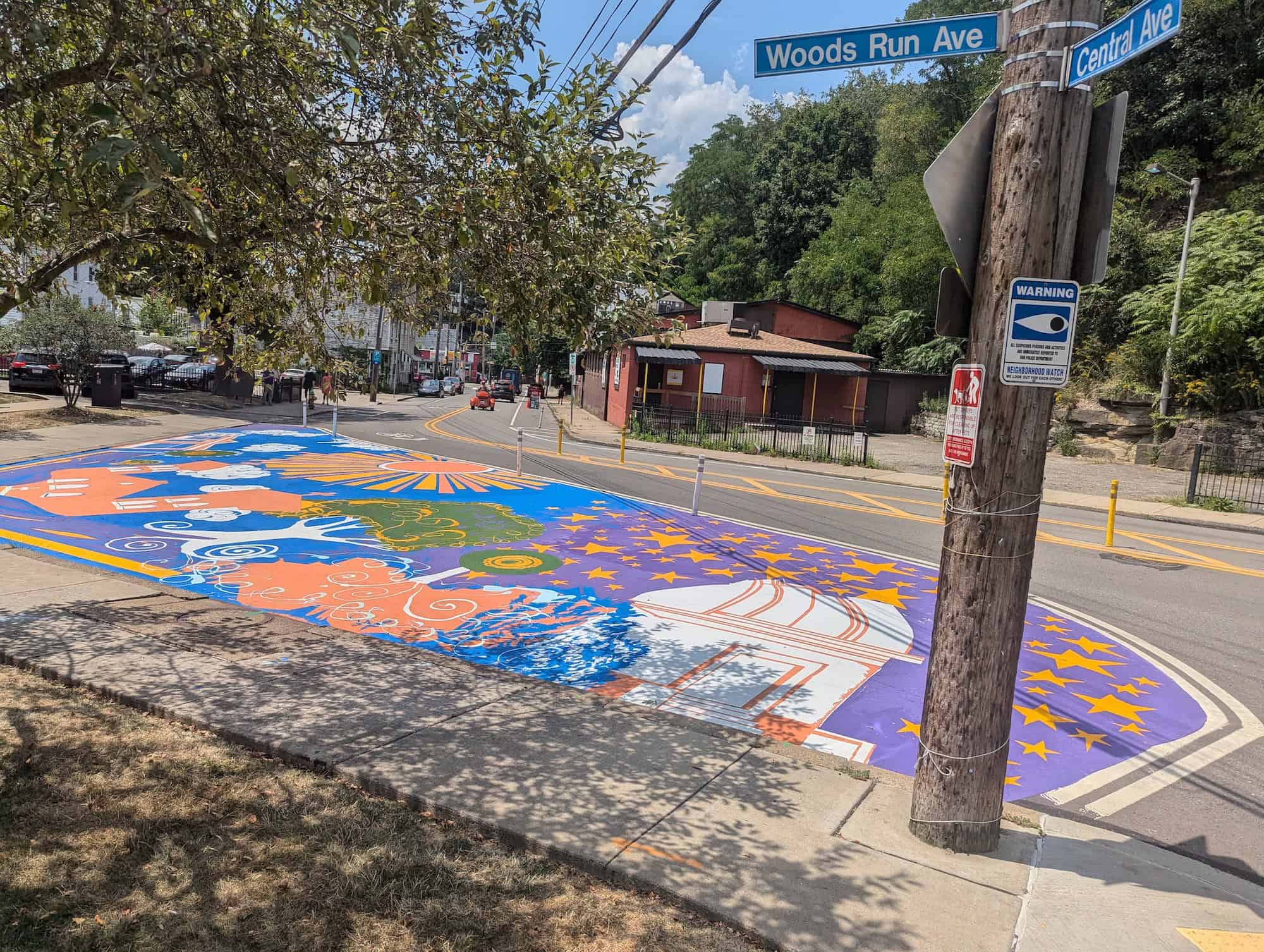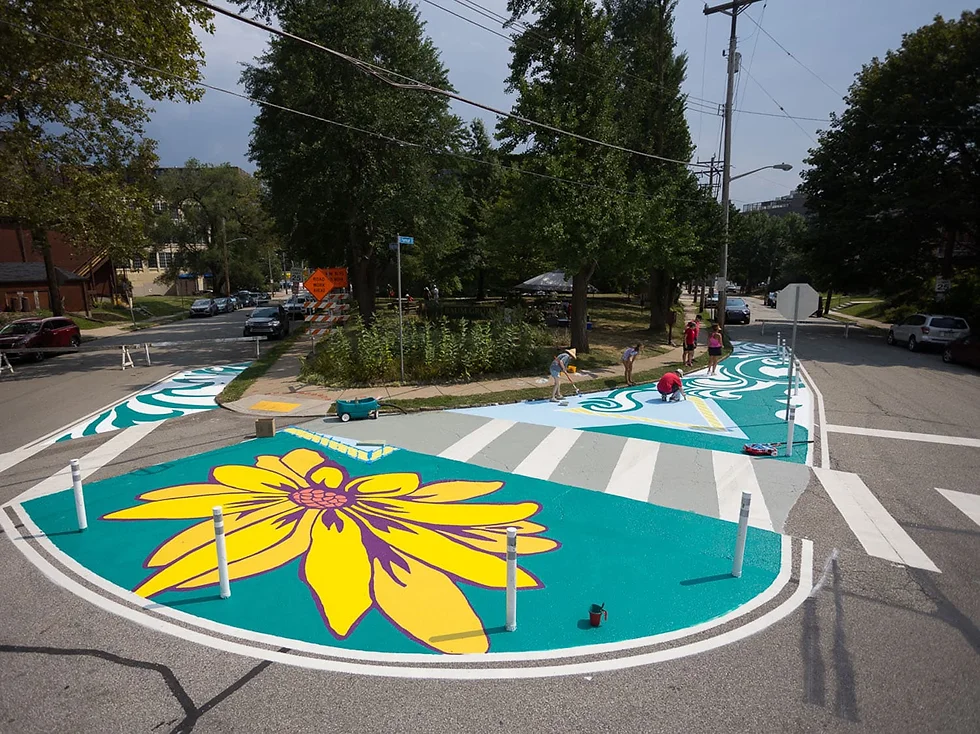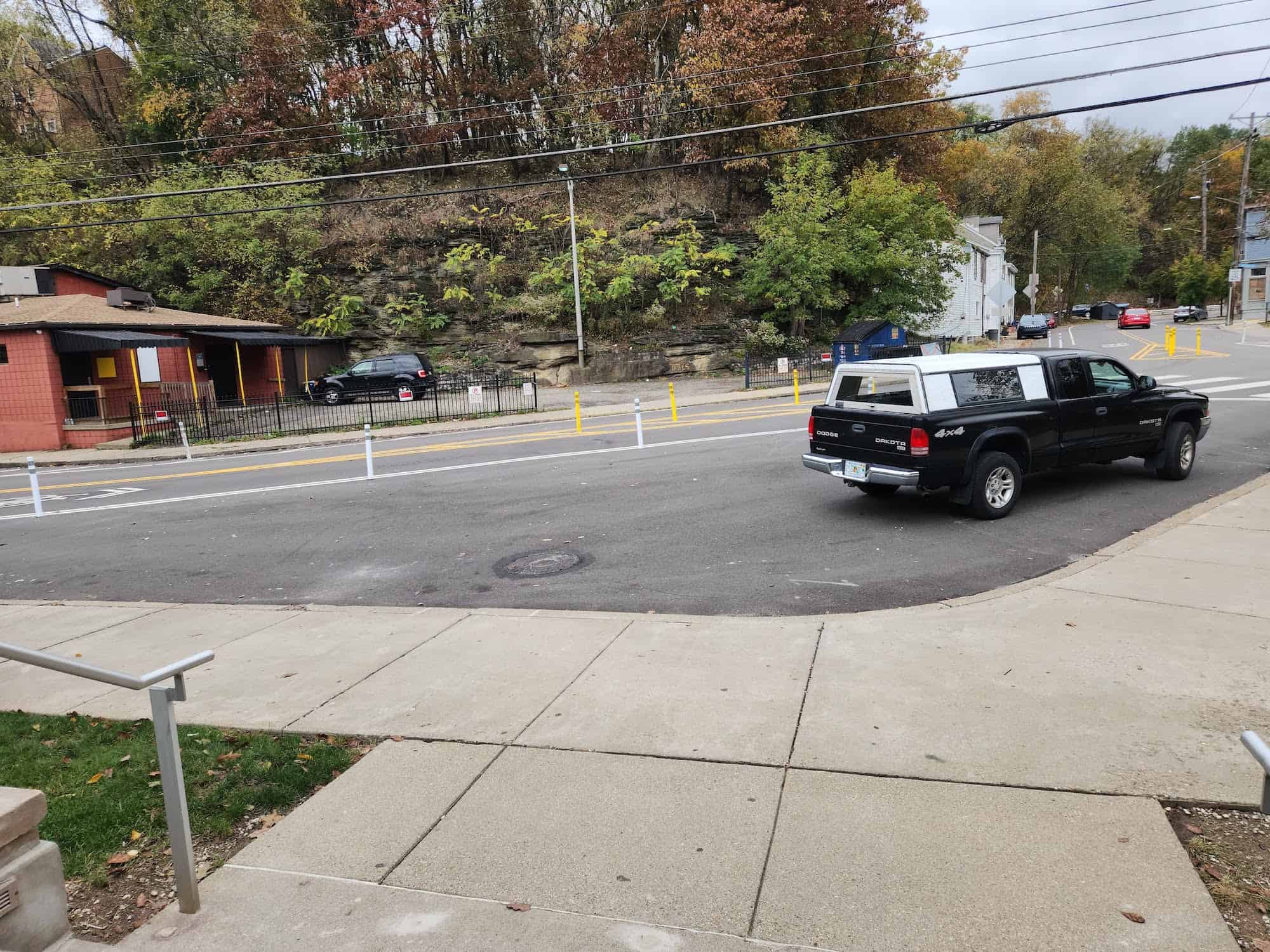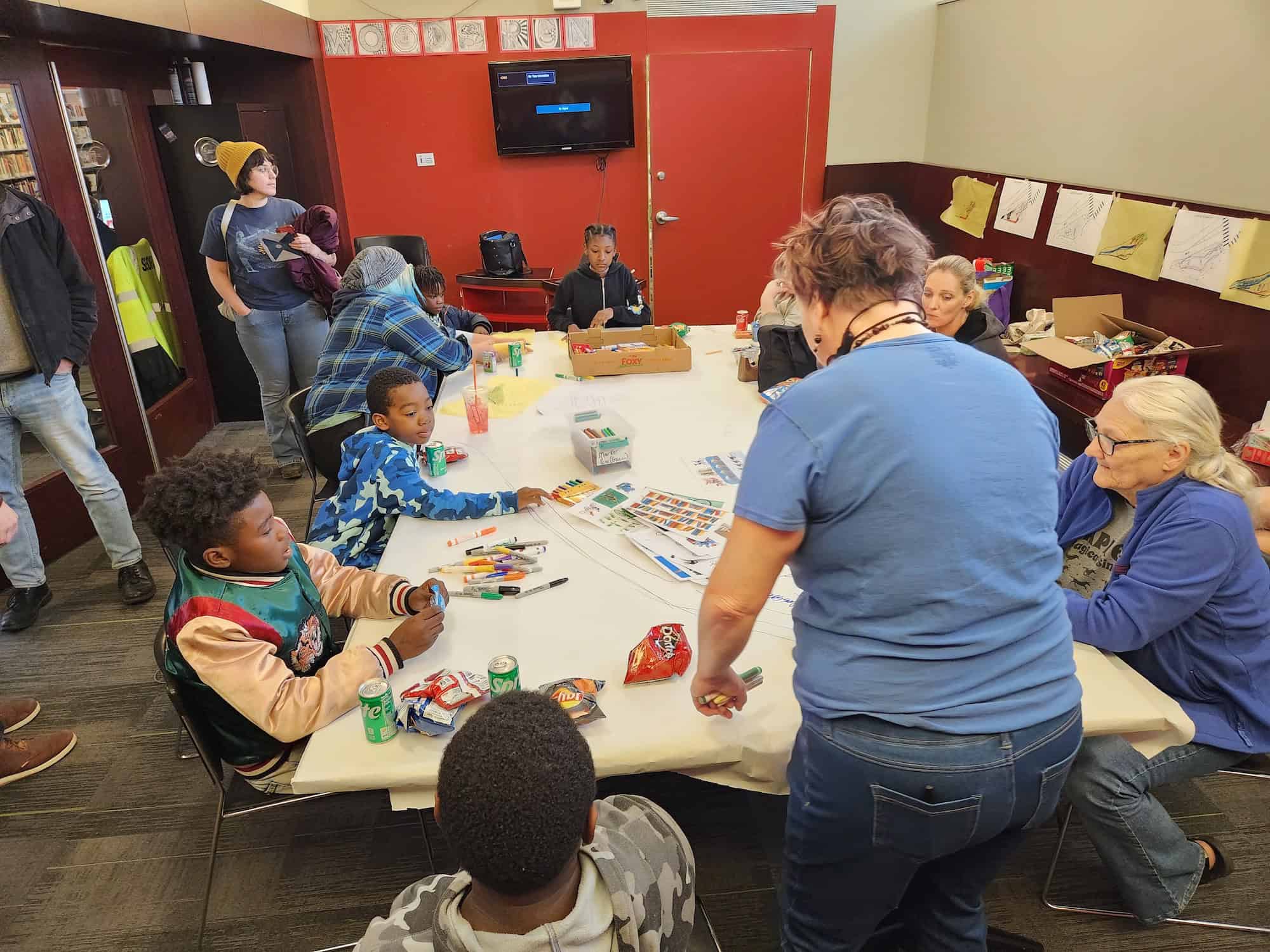
Hopefully our experience will help you in your quest for a traffic calming, on-street mural
In July, Bike Pittsburgh completed a 2,000 sq ft on-street asphalt street mural in front of the Carnegie Library of Pittsburgh Woods Run Branch in the Northside. Titled “Bikes and Books,” Bike Pittsburgh managed the project with assistance from artists Ashley Kyber and Tom Higgs, and financial support from AARP’s Community Challenge Grant. Within the City of Pittsburgh, there were two other asphalt murals installed over the past few years – one in Friendship at the confusing intersection near the Baum Grove Parklet, and the second in front of Friendship Park near West Penn Hospital.
For our mural, the City’s Department of Mobility and Infrastructure (DOMI) completed the engineering and installation of the area to be painted in 2023 as part of their “Trail to Mairdale” Neighborway and traffic calming project on Woods Run Ave, connecting the Chateau Trail and Riverview Park. DOMI’s project added many pedestrian and bike friendly features along the corridor to calm traffic and promote safety, leaving a large, triangle-shaped area of blank asphalt directly in front of the Carnegie Library, Woods Run Branch. The area was a perfect canvas to add public art, to create a sense of place, and to showcase the neighborhood.

Why street murals?
Asphalt mural art has emerged as an effective way to help calm traffic and to create vibrant places atop large areas of street surface. The benefits of such projects extend beyond aesthetics. A March 2022 Asphalt Art Safety Study, conducted by Sam Schwartz Consulting in partnership with Bloomberg Philanthropies, found that city streets with asphalt art became considerably safer for pedestrians, and can contribute to increased pedestrian traffic, improved road safety, reduced urban heat island effect, and a greater sense of civic pride.
Comparing the average of crash rates for before and after the analysis periods, results from the crash analysis of the study include:
- 50% decrease in the rate of crashes involving pedestrians or other vulnerable road users
- 37% decrease in the rate of crashes leading to injuries
- 17% decrease in the total crash rate
Asphalt art is win-win for neighborhoods. As we reclaim public spaces for artistic expression, we are also creating safer, more welcoming streets for neighbors to enjoy. Due to the success of previous asphalt art projects and their demonstrated benefits, DOMI agrees, and is looking to increase the use of asphalt art in other locations to help achieve their safety goals and enhance the positive traffic calming effects of their projects.
We put together this blog post to help interested residents and community groups navigate the hurdles and challenges of installing a street mural in the public right of way, and to equip you with some tools to assist. Our goal is not to intimidate you, but to help you set expectations before you get started. Please feel free to reach out to us if you have any questions!
Expectations
So far, there have been only three street murals on city streets next to moving traffic. Ours ended up being the fastest from conception to implementation, and that took a full year.
As this is a new process for all parties involved, any new mural will benefit from previous efforts. DOMI has also standardized the process, so the inevitable red tape and permission process is easier to navigate than ever before. But it is still not without its challenges. There is no step by step process for this, rather, it’s more like juggling different tasks and departments all at once.
To be clear, DOMI does not fund, design, nor install street murals, but are there to assist communities who want to install them within the confines of the law, existing standards and regulations.

Identify a site
Ideally, you’ll have a site that DOMI has already marked out and did the engineering work for. Look for existing intersection bump outs, or see if you can tag onto an upcoming traffic calming project. Otherwise, you will be responsible for the engineering work, which will need to be drawn up by a professional traffic engineer, and approved by DOMI.
This was one key difference between our project and the other two – we didn’t need to spend time and resources designing the traffic control markings to specifications as DOMI had already done that part. Bonus: There was already an Engage Page (the City’s public communication portal) for the project that we were able to use for outreach and to post updates.
Since so much traffic calming has been installed in the past several years, there are more options than ever for street mural art. Additionally, you’ll want to pick a site that won’t get repaved within the next few years. Finally, try to find a site that will make a difference in terms of calming traffic or with beautifying a public space.

Funding and budgeting
You’ll need to pay for the project as the city doesn’t provide funds for street murals. We received financial support from AARP’s Community Challenge Grant, however other options do exist.
Some things you should consider in your budget include: Artist services, expert help, snacks, materials, supplies, safety equipment, permits, site prep, vehicle rental, insurance, and even removal and maintenance of the mural.
You may also be able to get donations of supplies, materials, services, and equipment, but we encourage you to pay your artists!
Assemble a team
You’ll want a community champion on your team aside from yourself. It will help if you are working with a registered non-profit community group that has a positive reputation in the neighborhood and that can also accept donations to provide a receipt to a donor. Additionally, you’ll need an organization that is able to procure insurance, a key part of the Maintenance Agreement (more on this below).
You’ll also want to find an artist to help develop an image and that ideally has experience in painting outdoor murals. There are many technical and material questions that they should be able to answer, and ideally already have a relationship with materials suppliers. Finally, you’ll want someone to assist with public engagement and community design. We were lucky to have found an artist that had experience in both installing public art as well as the public process to create and envision the design.

Community Outreach
It’s important to have buy-in from the community on the design, as these are the people who will be looking at the mural every day. This can be accomplished in a number of ways. Since we were working with a library and supportive staff, we decided it would be best to have three design charrettes at the library itself in the hopes of bringing in existing patrons who are there daily. There are plenty of ways to build consensus, so hopefully the artist you choose has experience in facilitating a community design process.
The Red Tape
Department of Mobility and Infrastructure (DOMI)
The red tape can get frustrating and may feel overwhelming, but go into the project with the understanding that things like this take time. There are a number of hoops you’ll need to work through, but thankfully there are staffers at DOMI, the Right of Way Managers, who can assist you, and who will ultimately be issuing the permit.
The Permit and the Maintenance Agreement are the single most important things to work on, and there are pieces of it that you can get started on immediately. First step: Create a OneStopPGH account to help you manage the steps for the required Minor Encroachment Permit you are seeking. Then contact DOMI to spell out your idea and intentions. Together, you and DOMI can begin the process of negotiating the draft Maintenance Agreement that they provide to get you started.
There are several things on the permit and the maintenance agreement that you’ll need to figure out yourself. For instance, it will be on you, the project manager, to contact and document all of the relevant utilities to ensure that they have no plans to dig right where you plan to paint your mural. Additionally, the City requires that you have some basic liability insurance to cover the installation of the artwork, which for us, BikePGH was able to provide. This is usually pretty inexpensive for an existing non-profit organization. There are other permissions and agreements to sign off on, and DOMI will walk you through these.
Finally, you’ll need to figure out who is responsible for maintaining the artwork. The permit will be issued for three years, where you will then need to either a) renew the permit for another three years by showing that the artwork is still in good condition, or b) remove it, which you will be responsible for.
DOMI will also be able to assist on the material specs in terms of what kind of paint they require that you use.
Department of City Planning (DCP)
Before going onto the next step, you’ll need to work with the Department of City Planning to host what’s called a Development Activities Meeting (DAM) with the registered community organization (RCO).
If the site of your project is within the boundaries of a Registered Community Organization (RCO), the Pittsburgh Administrative Code requires that a Development Activities Meeting (DAM) be held at least 30 days before the Public Art Review Committee Hearing (see below). You can identify areas covered by RCOs using this GIS Map. The full guidelines for Development Activities Meetings can be found on their Development Activities Meeting (DAM) webpage.

Public Art and Civic Design Commission
The other big hurdle is the Public Art Review Committee of the Public Art and Civic Design Commission, composed of appointed professionals who review and approve the addition, modification, relocation, and removal of items of Public Art in the Public Realm. You should expect at minimum, two months for this process. There is also a staffer at the Department of City Planning who manages the commission (but is non voting) to help you navigate the process.
The two steps that are part of the Art Commission process include 1) the Preliminary Review and 2) a formal Hearing and Action. As these have strict application deadlines, the best you can hope for is to apply for the preliminary review in one month, then the formal hearing the following month.
Their website has a very thorough and informative FAQ section that will spell out the process and requirements. Also, be sure to read their application guidelines document which will spell out exactly what you need to prepare and provide for the review.
The preliminary review is there to help give you guidance and to make sure you have your ducks in a row before going to a formal hearing. This is where you will make your case and provide any supplemental materials to explain your plans. There’s a fine line for when to apply for the preliminary hearing. You will want your idea fleshed out enough to give the Art Commission confidence in your execution and concept, but also ensure that they still have the opportunity to provide feedback. From this preliminary review, you’ll get feedback and questions that the commission will want to see answered for the formal hearing.
For the formal hearing, which you can attend via Zoom, the Committee will hopefully be familiar enough with your project that you won’t need to go through explaining the whole thing. You’ll have five minutes to provide a brief presentation to them, where they’ll then have the opportunity to directly ask you questions about your project. Once they are finished with their questions, they will immediately vote on whether to approve or reject your proposal. Assuming you went through all of the above requirements, you needn’t worry that you will get a rejection at this stage.
Pittsburgh City Council
Once you are in agreement, the Maintenance Agreement document will go to City Council for their approval, just like any other contract with the City. Once approved by Council, there are a series of online signatures that will be collected, ending with the Mayor and you, the project manager (or head of the sponsoring organization). As soon as everyone signs, your permit is finalized and you are free to begin painting the mural.

Painting
This is always the fun part.
Ideally your artist will have experience both painting the outdoors and directing volunteers. Also, as you’ll be working next to active traffic, it’s important to be sure to keep your work area safe and free from automobiles. For the Woods Run Mural, we benefited from DOMI’s previous installation of bollards around the work area to keep cars out. However, some murals, such as the ones around Friendship Park, do not have bollards, so you’ll need to create a temporary enclosure.
Another factor is obviously the weather. You’ll need a dry surface within the temperature range of the paint you are using. We happened to be painting during a heatwave, where temperatures were too high during the day, so our artists chose to paint in the morning and the evening. We got lucky in that the overhead street lights were bright enough to work after sundown. Hopefully things work out for you that you can paint in milder temperatures.

Celebrate!
The CLP Woods Run Mural happened to align with the 50th Anniversary of the Library’s current location, so we were able to coordinate the mural’s ribbon cutting along with the activities that the Library was planning. Be sure to find comically large scissors!
Already, the Library is seeing benefits from the installation. Cars are slowing down, it’s easier for patrons to cross the street, and it has created a discussion piece for the neighborhood.
We hope that this was a helpful briefing on the process to install an asphalt art street mural. Let us know if you have any further questions – we’re here to help!
